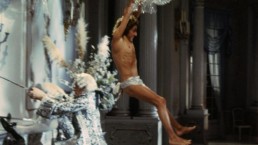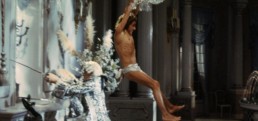Restoration Theatre: ‘Lisztomania’ @ American Cinematheque
This is a custom heading element.
A couple of years ago, I excitedly mentioned to an editor I was working with that I was going to see McCabe and Mrs. Miller at the Aero (and I reviewed it here).
Being a lifelong cinephile himself, he was happy for me, but also scoffed at how LA art-house screenings, in his eyes, didn’t get it right. How, I asked? In Paris, where he was from, a film restoration would play for at least a week, giving the film time to gain word of mouth and traction, often driven by critic recommendations. At the time I wrote this off and since have enjoyed many movies at the Aero, the Egyptian, and other restoration venues. After my most recent visit to the Cinematheque in late September to see Lisztomania (more on the movie in a second), I had an idea: why not review the films seen here anyway? So that maybe those who read about it can still find it for themselves, or catch it the next time it makes its way into town?
It’s no secret at Cinemacy that many of the films we covered are hard to come by, especially for those outside of LA. This is made even more difficult by the ever-changing landscape of independent film, where it’s no longer an axiom that films will end up getting a DVD release. Sharing a love of cinema is not only about staying current or catching rising talent, but also examining the films that have stood the test of time long enough to still get a theatrical run somewhere, even for one night only. And LA is the city for that. In the last 2 years, I’ve had the privilege of seeing El Topo, Freaks, Barry Lyndon, Rhino!, and Blow Out in these types of venues. All would be worth a written discussion.
So I’d like to kick off a new initiative, somewhat sporadic for the time being, of covering movies seen at restoration theaters. After all, most of the films are available online somewhere (if not for purchase) or will make their way to LA theaters again sometime. And the inaugural film is one that must not be forgotten: Ken Russell’s multigenre musical Lisztomania.
Released only a few months after the much more well-known Tommy and reuniting director Russell with the star Roger Daltrey (of The Who), Lisztomania takes us all the way back to mid-1800s Europe, where Franz Liszt, the greatest piano performer of his time (of all time?), is touring the continent giving piano recitals. But we’re seeing this story through the lens of the 1970s and rock opera. Liszt was considered the first rock star, in the sense that when he toured the world he was a sensation everywhere he performed. So this film juxtaposes the modern definition of a rock star with this old-fashioned world, and the result is spectacular. In an extended opening concert, Daltrey as Liszt plays to a crowd of screaming girls (think Beatles fans level excitement)… except they’re all dressed in 19th-century garb. Its mixture of old and new and jumping between time periods, while entirely feeling like a hallucinogenic trip, is a blast to behold. Some could call it incoherent, I found it quickly engrossed and so radically spectacular that I stopped worrying about where exactly the story was going quickly. If you’re expecting a biography of Franz Liszt, forget it, you’re in the wrong movie. Lisztomania begins with a surreal sex-driven sword fight (enhanced by the music of course) and only goes further astray from there. And that comes with a shining recommendation.
However, in today’s landscape where so much emphasis is on authenticity and capturing realism on film unless we visit movies like this, it’s easy to forget how wild and crazy movies can potentially be.
One of the biggest distinctions is that it takes it back to a much different era of filmmaking where soundstages were the primary filming locations as opposed to real places. By building from scratch, it makes the world of the film so much more immersive, and the set pieces are both stunning and cheeky in their humorous, outlandish choices. Expect plenty of phallic imagery. It’s a reminder of how much more theatrical this era of filmmaking was, with bigger budgets towards these set pieces that created something singular for that film only, nothing you’d expect to see in any real setting. The result of this imagination-driven creativity speaks for themselves.
I’ve since read complaints that the film’s obscure references to classical music history through in-jokes make it an alienating experience. However, in today’s landscape where so much emphasis is on authenticity and capturing realism on film unless we visit movies like this, it’s easy to forget how wild and crazy movies can potentially be. I would also argue that the film’s implementation of both the rock opera music, and more importantly, the classical music of Liszt, is so innovative and masterful that no matter what level of knowledge you have on the history, it’s impossible not to be in awe. Throughout the trippy sequences in different fictionalized time periods, classical music remains a throughline. Undoubtedly, no matter how much fun Daltrey, Russell, and Co. were having, these are people that have an unmatched love for great music. And their artful, often impossible to verbalize take on Liszt, shows how well they care for the musical masters.
Lisztomania was released in 1975, the same year as both Barry Lyndon and The Rocky Horror Picture Show. It wouldn’t be a stretch to call this film a love child between the two. And I am so down. Immediately after seeing the movie I couldn’t wait to experience it again next time it’s in town and confidently can add it to my favorite movies list.
H. Nelson Tracey
Nelson is a film director and editor from Denver based in Los Angeles. In addition to writing for Cinemacy, he has worked on multiple high profile documentaries and curates the YouTube channel "Hint of Film." You can check out more of his work at his website, hnelsontracey.com


